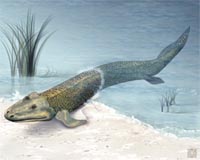| . |  |
. |
Washington (AFP) Jan 28, 2010 US paleontologists said Thursday they have uncovered a new dinosaur species in China's Gobi Desert that could explain how one dinosaur family came to look like birds. The finding extends by 63 million years the fossil record of the Alvarezsauridae family, a group of bird-like dinosaurs with a large claw on their hands and very short, powerful arms. It was the first evidence that this type of dinosaurs lived during the Late Jurassic era, about 160 million years ago. Halfway between birds and dinosaurs, this group -- which George Washington University doctoral candidate Jonah Choiniere named Haplocheirus sollers (meaning skillful hand) in his study published in Friday's issue of the journal Science -- looks a bit like today's gamefowl. It also had a long neck and head, as well as extended, hairless limbs. The claw may have been used for digging termites. "Haplocheirus is a transitional fossil, because it shows an early evolutionary step in how the bizarre hands of later Alvarezsaurs evolved from earlier predatory dinosaurs," Choiniere said in a statement. "The fossil also confirms our predictions that Alvarezsauridae should have been evolving in the Late Jurassic time period." The fossil of the newly discovered species has several features linking it to Alvarezsauridae, which included species like Mononykus (meaning one claw) and was previously thought to be a flightless offshoot of ancient birds. But despite the Alvarezsauridae's skeletal similarities to ancient birds, Choiniere's findings showed that the dinosaur family evolved in parallel to birds and was not descended from them. The Late Jurassic period played a key role in the evolution of birds. Some evidence suggests birds first evolved from theropod (bird-footed) dinosaurs -- the ancestors of predator dinosaurs like T. rex. The nearly complete Haplocheirus sollers specimen skeleton, which measures ten feet (three meters) long, was collected in 2004 during expeditions to China's remote northwestern Xinjiang region by James Clark of The George Washington University and Xu Xing of the Chinese Academy of Sciences, who co-wrote the study. "The primary goal of our expeditions was to find evidence of the theropod dinosaurs closest to birds, and the discovery of Haplocheirus is one of our major discoveries," said Clark. "This spectacular skeleton shows how the strange arms of Mononykus and other Alvarezsaurs evolved from a more typically theropod grasping hand." The National Science Foundation (NSF) Division of Earth Sciences, the National Geographic Society, the Chinese National Science Foundation and The George Washington University funded the research.
Share This Article With Planet Earth
Related Links Explore The Early Earth at TerraDaily.com
 Fossil Footprints Give Land Vertebrates A Much Longer History
Fossil Footprints Give Land Vertebrates A Much Longer HistoryUppsala, Sweden (SPX) Jan 11, 2010 The discovery of fossil footprints from early backboned land animals in Poland leads to the sensational conclusion that our ancestors left the water at least 18 million years earlier than previously thought. The results of the Polish-Swedish collaboration are published online this week in Nature. These results force us to reconsider our whole picture of the transition from fish to land ani ... read more |
|
| The content herein, unless otherwise known to be public domain, are Copyright 1995-2009 - SpaceDaily. AFP and UPI Wire Stories are copyright Agence France-Presse and United Press International. ESA Portal Reports are copyright European Space Agency. All NASA sourced material is public domain. Additional copyrights may apply in whole or part to other bona fide parties. Advertising does not imply endorsement,agreement or approval of any opinions, statements or information provided by SpaceDaily on any Web page published or hosted by SpaceDaily. Privacy Statement |